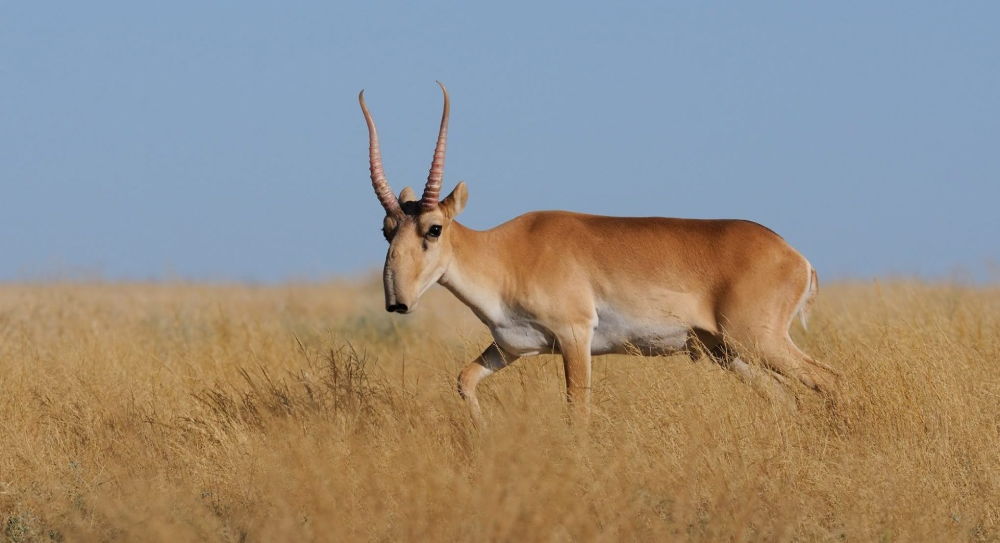The Saiga Antelope (Saiga tatarica) is an extraordinary species known for its unique appearance and critical role in the ecosystems of the Eurasian steppes. Characterized by its distinctive, bulbous nose and migratory behavior, the Saiga has fascinated scientists and conservationists alike. This article explores the Saiga’s evolutionary history, ecological significance, threats, and the ongoing conservation efforts aimed at preserving this remarkable animal.
Evolutionary History
The Saiga Antelope is a relic from the Pleistocene epoch, a period that began about 2.6 million years ago and lasted until about 11,700 years ago. During this time, the Saiga roamed alongside mammoths and saber-toothed cats, adapting to the cold, arid environments of the steppe regions. Its unique nasal structure, which serves as a filter and a cooling mechanism, is an adaptation to the dusty, dry conditions of its habitat.
Genetic studies suggest that the Saiga’s closest relatives are found within the Bovidae family, which includes sheep, goats, and other antelope species. Fossil records indicate that Saiga once had a much broader range, extending from the British Isles to Alaska. However, climate changes and human activities have since restricted their habitat to isolated regions in Kazakhstan, Russia, Mongolia, and Uzbekistan.

Ecological Significance
The Saiga plays a crucial role in the steppe ecosystems. As a migratory species, it helps maintain the health of grasslands through grazing, which prevents overgrowth and promotes biodiversity. The Saiga’s grazing patterns also aid in seed dispersal, contributing to the regeneration of plant communities.
Moreover, the Saiga serves as prey for large predators such as wolves and eagles, thus occupying an essential niche in the food web. The loss of Saiga populations would likely result in significant ecological disruptions, highlighting the importance of their conservation.
Threats to Survival
Despite their ecological importance, Saiga populations have faced dramatic declines, particularly in the late 20th and early 21st centuries. Several factors contribute to their precarious status:
1. Poaching: The Saiga’s horns are highly valued in traditional Chinese medicine, leading to rampant poaching. This illegal trade has decimated male populations, skewing sex ratios and hampering reproduction.
2. Habitat Loss: Agricultural expansion, infrastructure development, and human encroachment have reduced the Saiga’s natural habitat, limiting their migratory routes and access to resources.
3. Climate Change: Changes in climate have led to alterations in the Saiga’s habitat, affecting food availability and increasing the frequency of extreme weather events. Droughts and severe winters can result in mass die-offs.
4. Disease: The Saiga is highly susceptible to diseases such as pasteurellosis, which can cause sudden and widespread mortality. In 2015, a catastrophic outbreak killed over 200,000 Saigas in Kazakhstan, nearly wiping out the entire population.
Conservation Efforts
Recognizing the critical state of the Saiga, numerous international and local organizations have initiated conservation efforts to protect and restore Saiga populations. These efforts include:
1. Anti-Poaching Initiatives: Enhanced patrols and stricter enforcement of wildlife protection laws have been implemented to combat poaching. Efforts are also being made to reduce demand for Saiga horns through public awareness campaigns and alternative medicine programs.
2. Habitat Protection: Establishing protected areas and wildlife corridors helps safeguard the Saiga’s habitat and migratory routes. For example, the Altyn Dala Conservation Initiative in Kazakhstan focuses on creating vast protected landscapes for Saiga and other wildlife.
3. Scientific Research and Monitoring: Ongoing research on Saiga ecology, genetics, and disease dynamics is crucial for informed conservation strategies. Satellite tracking and population surveys help monitor Saiga movements and population trends.
4. Community Engagement: Involving local communities in conservation efforts is essential for sustainable success. Programs that promote alternative livelihoods and educate communities about the ecological importance of the Saiga help foster local support for conservation initiatives.
5. International Collaboration: Conservation of the Saiga requires cross-border cooperation due to their migratory nature. International agreements and collaborations, such as the Memorandum of Understanding concerning Conservation, Restoration, and Sustainable Use of the Saiga Antelope under the Convention on Migratory Species, play a pivotal role in coordinated conservation efforts.
Conclusion
The Saiga Antelope is a symbol of resilience and adaptation, having survived drastic changes in its environment over millennia. However, the modern challenges of poaching, habitat loss, climate change, and disease require urgent and sustained conservation efforts. By addressing these threats through comprehensive and collaborative strategies, there is hope that the Saiga will continue to roam the steppes of Eurasia, maintaining the ecological balance and inspiring future generations. The story of the Saiga is a poignant reminder of the intricate connections between species and their environments, and the shared responsibility to protect our planet’s biodiversity.









